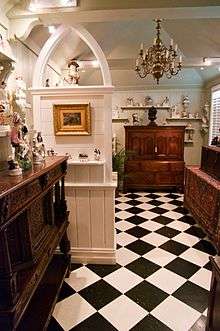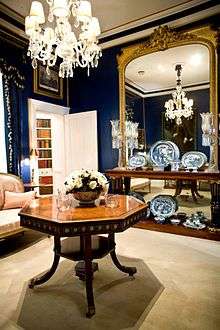The Johnston Collection
 The kitchen | |
| Established | 1990 |
|---|---|
| Location | East Melbourne |
| Founder | William Robert Johnston |
| Website | www.johnstoncollection.org |
The Johnston Collection is a museum of fine and decorative art in East Melbourne, Victoria. The museum complex incorporates the house museum, Fairhall, as well as a gallery and reference library. The WR Johnston Trust was founded in 1986 as the result of a bequest by the late William Robert Johnston, a prominent 20th century antiques dealer and collector of Georgian, Regency and Louis XV furniture, 18th and 19th century porcelain, and paintings ranging from the 16th–19th centuries.
The Collection, which first opened in 1990, as part of the Spoleto Festival (now the Melbourne International Arts Festival), operates as an independent not-for-profit museum. Today, the Collection incorporates over 1200 objects, and plays host to regular rearrangements and exhibitions. It is open to the public every weekday, with three tours per day conducted by volunteer guides.
Because the Collection is situated in a residential area, the address is not available to the public, and visitors are transported by courtesy bus from a nearby collection point, the location of which is advised at the time of booking.
William Johnston



Born in Lilydale, Victoria in 1911, William Robert Johnston was the son of a boot maker and a scullery maid. Around the age of eight, he was given a Minton cup by his grandmother. This became the first piece of his collection and provided the inspiration for a career in antiques that would take Johnston around the world. At 14, he left school to work as a window dresser in Buckley and Nunn (now David Jones), where he continued to develop his interest in decoration and arrangement. After World War II, Johnston travelled to Britain where many owners of English country houses, suffering financial hardship after the war, were willing to discreetly sell their antiques.
Johnston established a residence and warehouse in Greenwich, London, shipping container loads of antiques back to Melbourne for sale by auction. In 1952, he purchased Cadzow, a Victorian terrace house in East Melbourne, Victoria, which he would rename Fairhall. He continued to travel between England and Australia for the next 20 years, also making regular visits to India, Egypt, and Tunisia where he acquired antiques that he would export back to Melbourne for sale.
In the 1970s, when Melbourne became his major base, he established Kent Antiques in High Street, Armadale. Although most of the furniture and antiques sold here were Victorian (in accordance with the popular taste of the time) his own preference was for the Georgian and Regency periods. Consequently, his collection was composed predominantly of 18th and early 19th century furniture and fine and decorative art. Much of this collection was housed at Johnston’s country property, Chandpara, situated at Tyldon, Victoria.
Johnston suffered his first heart attack in 1972. With his health deteriorating, he decided that he wanted the bulk of his vast antique collection to be available to the public after his death, and began to make arrangements to this effect. Johnston suffered a fatal heart attack in India in 1986. He was buried in Lilydale following a Catholic ceremony.
Fairhall

Fairhall is a two storey brick house constructed in 1860, which now houses The Johnston Collection of fine and decorative art. Constructed in 1860, and originally named Cadzow, the house was purchased by William Johnston in 1952. Johnston occupied the house from 1972, until his death in 1986. Internally the structure of Fairhall remains essentially as Johnston left it. Under his ownership, the house was remodelled to simulate the appearance of a Georgian townhouse. These alterations included changes to the fenestration, the replacement of the front door and the insertion of a semicircular fanlight. The house and its collection were bequeathed to the people of Victoria by Johnston shortly before his death.
Fairhall was converted into the house museum, and a courtyard garden was designed by John Patrick in the English manner to highlight Johnston’s love of gardening. In accordance with Johnston’s wishes, the Collection is displayed in a domestic setting within Fairhall, without labels, ropes or barriers. All visitors are conducted through the house by volunteer guides. There is an established tradition of re-dressing and decorating Fairhall, initiated by Johnston himself. Johnston often brought his decorating skills to the fore, rearranging the furniture, not only in Fairhall but also his country property Chandpara and his shop Kent Antiques, to make little vignettes within the spaces. Today, the Collection is rearranged for three themed tours per year, with guest curators invited to interpret the space. These have included Lynne Landy and Lady Potter, fashion designer Akira Isogawa, decorator Robert Thomson, and antique dealers Jamie Allpress and Francis Dunn.
The Gallery
The Johnston Collection Gallery opened in 2007. Each year two exhibitions are mounted in this space, the themes of which are linked to the museum’s permanent collection. The Gallery also plays host to a diverse program of public lectures and study days.
Reference Library
The Johnston Collection Reference Library, incorporating The Copland Decorative Arts Library and The Davidson Fine Arts Library, is located in the administration wing of the museum. It includes a large variety of recent and historical publications relating to fine and decorative art. The Library is available for use by appointment.
Christmas at The Johnston Collection
Every year Fairhall is decorated for the "Christmas at The Johnston Collection" tour. Selected artists and craftspeople are invited to create decorations which are displayed throughout Fairhall. The decorations must be inspired by the objects in the Collection, the story of William Johnston, and/or the story of Christmas itself.
Collection highlights

- Peter Archambo I
- Hester Bateman
- Mary Beale
- Bow Porcelain Factory
- Adam Buck
- Richard Cosway
- Derby Porcelain
- Gainsborough Dupont
- Joseph Highmore
- Henry Hindley
- Utagawa Hiroshige
- William Hogarth
- William John Huggins
- Thomas Luny
- Jean David Maillardet
- Minton
- Jean-Baptiste Monnoyer
- Robert Peake
- Giovanni Battista Piranesi
- Salvator Rosa
- Jacob Sang
- James Scouler
- Sèvres porcelain
- John Smart
- Abraham Storck
- Staffordshire Potteries
- Wedgwood
- Royal Worcester
References
- Anthony Knight, The Johnston Collection, The W.R. Johnston Trust, 1997
- The Johnston Collection history
- ADFAS
- East Melbourne Historical Society
External links
| Wikimedia Commons has media related to The Johnston Collection. |
- Official website
- The Association of Australian Decorative and Fine Arts Societies (ADFAS)
- Only Melbourne
- National Seniors Association
- Melbourne.com
Coordinates: 37°48′50″S 144°59′06″E / 37.81385°S 144.98507°E